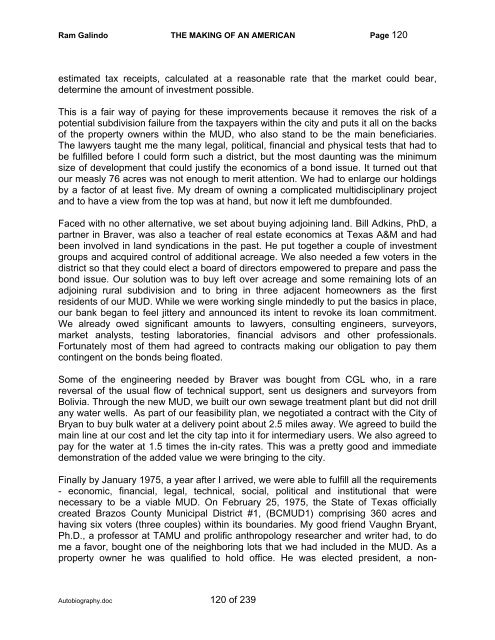Autobiography - The Galindo Group
Autobiography - The Galindo Group
Autobiography - The Galindo Group
Create successful ePaper yourself
Turn your PDF publications into a flip-book with our unique Google optimized e-Paper software.
Ram <strong>Galindo</strong> THE MAKING OF AN AMERICAN Page 120<br />
estimated tax receipts, calculated at a reasonable rate that the market could bear,<br />
determine the amount of investment possible.<br />
This is a fair way of paying for these improvements because it removes the risk of a<br />
potential subdivision failure from the taxpayers within the city and puts it all on the backs<br />
of the property owners within the MUD, who also stand to be the main beneficiaries.<br />
<strong>The</strong> lawyers taught me the many legal, political, financial and physical tests that had to<br />
be fulfilled before I could form such a district, but the most daunting was the minimum<br />
size of development that could justify the economics of a bond issue. It turned out that<br />
our measly 76 acres was not enough to merit attention. We had to enlarge our holdings<br />
by a factor of at least five. My dream of owning a complicated multidisciplinary project<br />
and to have a view from the top was at hand, but now it left me dumbfounded.<br />
Faced with no other alternative, we set about buying adjoining land. Bill Adkins, PhD, a<br />
partner in Braver, was also a teacher of real estate economics at Texas A&M and had<br />
been involved in land syndications in the past. He put together a couple of investment<br />
groups and acquired control of additional acreage. We also needed a few voters in the<br />
district so that they could elect a board of directors empowered to prepare and pass the<br />
bond issue. Our solution was to buy left over acreage and some remaining lots of an<br />
adjoining rural subdivision and to bring in three adjacent homeowners as the first<br />
residents of our MUD. While we were working single mindedly to put the basics in place,<br />
our bank began to feel jittery and announced its intent to revoke its loan commitment.<br />
We already owed significant amounts to lawyers, consulting engineers, surveyors,<br />
market analysts, testing laboratories, financial advisors and other professionals.<br />
Fortunately most of them had agreed to contracts making our obligation to pay them<br />
contingent on the bonds being floated.<br />
Some of the engineering needed by Braver was bought from CGL who, in a rare<br />
reversal of the usual flow of technical support, sent us designers and surveyors from<br />
Bolivia. Through the new MUD, we built our own sewage treatment plant but did not drill<br />
any water wells. As part of our feasibility plan, we negotiated a contract with the City of<br />
Bryan to buy bulk water at a delivery point about 2.5 miles away. We agreed to build the<br />
main line at our cost and let the city tap into it for intermediary users. We also agreed to<br />
pay for the water at 1.5 times the in-city rates. This was a pretty good and immediate<br />
demonstration of the added value we were bringing to the city.<br />
Finally by January 1975, a year after I arrived, we were able to fulfill all the requirements<br />
- economic, financial, legal, technical, social, political and institutional that were<br />
necessary to be a viable MUD. On February 25, 1975, the State of Texas officially<br />
created Brazos County Municipal District #1, (BCMUD1) comprising 360 acres and<br />
having six voters (three couples) within its boundaries. My good friend Vaughn Bryant,<br />
Ph.D., a professor at TAMU and prolific anthropology researcher and writer had, to do<br />
me a favor, bought one of the neighboring lots that we had included in the MUD. As a<br />
property owner he was qualified to hold office. He was elected president, a non-<br />
<strong>Autobiography</strong>.doc 120 of 239


